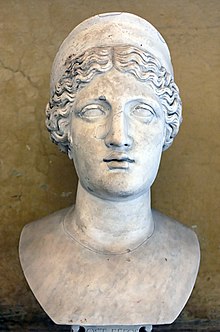Barberini Hera


The Barberini Hera, also known as Barberini Juno, is a Roman sculpture believed to be a copy of a Greek original depicting either Hera or Juno, two prominent goddesses in ancient mythology. Unearthed in Rome during the late 17th century, this sculpture now resides in the Museo Pio-Clementino.
Description
The statue depicts the goddess standing, wearing a crown and peplos (which clings to show her form beneath and has dropped from her left shoulder, nearly revealing her breast) and now resting the weight of her restored right arm on a standing sceptre and carrying a patera in her left. This sculpture is a Roman copy of a Greek original, possibly by Alcamenes; Lewis Richard Farnell suggested that "the not infrequent repetition of the type suggests a Greek original of some celebrity."[1] It is now in the Museo Pio-Clementino in the Vatican Museums. It is also sometimes identified as a Ceres. The right arm and the nose are restorations.
Discovery
The sculpture was discovered by the antiquarian Leonardo Agostini in the late 17th century, during excavations on the Viminal Hill. The site was located beneath the convent affiliated with the church of San Lorenzo in Panisperna, an area known to have hosted the ancient Baths of Olimpiades. Its identification as the Barberini Hera was established by its early owner, Cardinal Francesco Barberini.[2]
Notes
